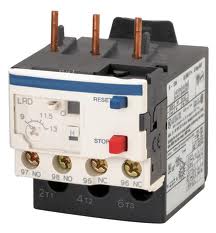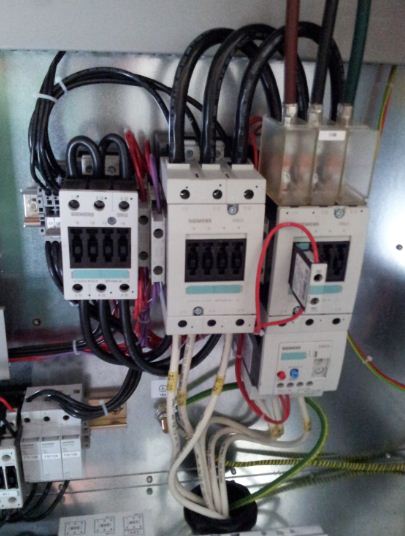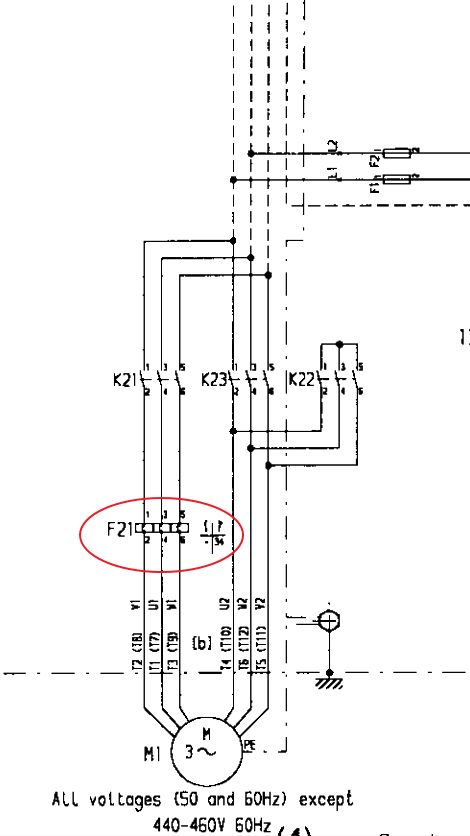In this second post in the 'part of the day' series, I will discus an important part that is found on almost all but the smallest (<2 kW) compressors: the overload relay. The overload relay is also often called the 'thermal block' or 'thermal relay'. This part protects your compressor from self-destructing when things go wrong. It continuously senses the current that the electric motor draws. When the current is too high for a too long time, the overload relay trips. In other words: the overload relay protects your motor.
The overload relay
This is what a typical overload relay will look like, as found on industrial air compressors. [caption id="attachment_179" align="alignnone" width="216"] Example of typical overload relay[/caption] The overload realy or thermal block has a few settings: - dial knob for setting the rated motor current
Example of typical overload relay[/caption] The overload realy or thermal block has a few settings: - dial knob for setting the rated motor current
- Manual / automatic reset selector
- Test button
- Reset button
It's common practise to set the trip current at 1.15 - 1.25 times the normal operation current of the machine. However, the setting should not be so high that the current couold damage the motor or wiring in case of a failure. Most of the time, we want to use the manual reset setting. If the breaker tripped, there is something wrong with your machine, so we need to investigate further what the cause of the tripping was, before resetting and re-starting the compressor. ## Overload relay / thermal block on industrial air compressors
Here are some photos of electrical cabinets of industrial air compressors. On each foto you can see the thermal relay. The thermal relay is 99% installed below the main contactor. All industrial compressors that don't have a VSD drive or 'soft starter', start up using start/delta starting. On the picture below you see the star contactor on the left, the delta contactor in the middle and the main contactor on the left. The thermal block/overload relay 'hangs' below the main contactor. [caption id="attachment_178" align="alignnone" width="405"] Overload relay on industrial air compressor (bottom right).[/caption] ## Why 'thermal block' and how do they trip?
Overload relay on industrial air compressor (bottom right).[/caption] ## Why 'thermal block' and how do they trip?
I know you might be wondering where the name 'thermal block' comes from. Inside the thermal relay are bimetal tripping elements. The more current flows through the relay, the hotter the bimetal tripping elements become.In case you don't know: bimetal bends when it becomes hot, and comes back straight when it cools down again. When there is an overload, a huge amount of current is drawn, the bimetal becomes really hot and bends. The thermal relay 'trips'. Because of the way the overload relay is contructed, it will trip quickly at a huge overload (within a second). But it will also trip on a small overload, this could even ben minutes or hours. Because of this, the thermal relay is perfect for protecting motors. When the motor stars, it draws huge amounts of current, but this doesn't trip the overload relay. However, if the motor runs heavy at 120% current for example for a few minutes or hours, the overload relay will trip, to protect the motor.
Electrical connections and how the overload relay stops the motor
Here is a typical electrical diagram of an industrial air compressor. As we have seen in the picture above, the overload relay 'hangs' (literally) under the main contactor. When the overload relay trips, it does NOT open the main connection itself. Instead, a small auxiliary contact opens, that signals to the central controller than an overload has occurd. The central controllers then stops the motor. On older machines, the auxiliary contact is connected in series with the excitation coil of the main contactor. If the overload relay trips, the main contactor loses power and opens. [caption id="attachment_180" align="alignnone" width="470"] Electrical connection of thermal overload relay on air compressor[/caption] ## Troubleshooting
Electrical connection of thermal overload relay on air compressor[/caption] ## Troubleshooting
I receive quite frequently questions about compressor tripping on the overload relay 'spontaneously', for no apparent reason.
My personal experience is that when these things get older, they tend to become too sensitive and might either trip spontaneously, or trip at a too low current. Often, it can't be reset either (pressing reset doesn't help).. which means it's time to replace the thing.
That's the 'part of the day' for today. Tomorrow we'll discuss another air compressor part.

Comments
No comments yet…
Log in or create an account to make a comment...